I have now tried to fix manually create error bars into my barplot? Is that possible and if yes, how do I do that? Furthermore, is it possible and how do I add text between to plots for showing significance levels? (such as Barplot with significant differences and interactions?)
I would appreciate any kind of help!
My code look like this:
pdf(file="barplo1.pdf", title="WHAT TITLE HERE?", pointsize=6, width=4, height=4, paper="special")
par(mfrow = c(3, 2), oma=c(0.5,0.5,0.5,0.5), mar=c(2,5,2,2))
barplot(c(36.5,49.8), names.arg = c("Low", "High"), beside = TRUE, ylab = "", main="Power", col = c("grey", "gray50"), ylim = c(0,100), cex.lab=1.7, cex.axis = 1.4, cex.names = 1.4, cex.main = 1.8, lwd = 0.5, border = NA)
text(0.71,39.5, "36,5 pct.***", pos=3, cex= 1.4)
text(1.9,52.8, "49,8 pct.***", pos=3, cex= 1.4)
barplot(c(39.5,50.6), names.arg = c("Low", "High"), beside = TRUE, main="", col = c("grey", "gray50"), ylim = c(0,100), cex.axis = 1.4, cex.names = 1.4, cex.main = 1.8, lwd = 0.5, border = NA)
text(0.71,42.5, "39,5 pct.***", pos=3, cex= 1.4)
text(1.9,53.6, "50,6 pct.***", pos=3, cex= 1.4)
barplot(c(33.5,50.1), names.arg = c("Low", "High"), beside = TRUE, ylab = "", col = c("grey", "gray50"), ylim = c(0,100), cex.lab=1.7, cex.axis = 1.4, cex.names = 1.4, lwd = 0.5, border = NA)
text(0.71,36.5, "33,5 pct.***", pos=3, cex= 1.4)
text(1.9,53.1, "50,1 pct.***", pos=3, cex= 1.4)
barplot(c(49.5,61.5), names.arg = c("Low", "High"), beside = TRUE, col = c("grey", "gray50"), ylim = c(0,100), cex.axis = 1.4, cex.names = 1.4, lwd = 0.5, border = NA)
text(0.71,52.5, "49,5 pct.***", pos=3, cex= 1.4)
text(1.9,64.5, "61,5 pct.***", pos=3, cex= 1.4)
barplot(c(40.0,48.5), names.arg = c("Low", "High"), beside = TRUE, col = c("grey", "gray50"), ylim = c(0,100), ylab = "", cex.lab=1.7, cex.axis = 1.4, cex.names = 1.4, lwd = 0.5, border = NA)
text(0.71,43.0, "40,0 pct.***", pos=3, cex= 1.4)
text(1.9,51.5, "48,5 pct.***", pos=3, cex= 1.4)
barplot(c(45.5,70.2), names.arg = c("Low", "High"), beside = TRUE, col = c("grey", "gray50"), ylim = c(0,100), cex.axis = 1.4, cex.names = 1.4, lwd = 0.5, border = NA)
text(0.71,48.5, "45,5 pct.***", pos=3, cex= 1.4)
text(1.9,73.2, "70,2 pct.***", pos=3, cex= 1.4)
dev.off()
